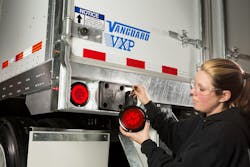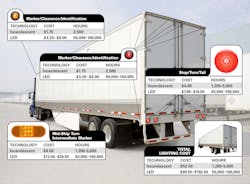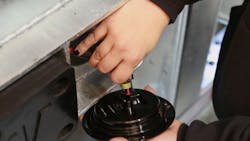The light emitting diode (LED) has established itself as the lighting technology of choice for the commercial vehicle industry. Decades of technological advancement of LEDs have seen traditional incandescent lighting phased out on commercial vehicles. With uptime as the driving force behind most vehicle specification considerations, LEDs have proven more reliable, durable, and longer-lasting. There are numerous benefits LEDs can offer and understanding these benefits can help fleets capitalize on cost savings and uptime.
Electroluminescence versus incandescence
LEDs utilize electroluminescence to create light.
“[The process of] electroluminescence [in LEDs] is the movement of electrons between two terminals of a diode,” says Dan Wallace, National Sales Manager, OEM Trailer Group, with Phillips Industries. “The LED is a diode itself. The power goes into the LED which has semiconductors. As the power flows back and forth between the semiconductors, it produces light.”
Phillips Industries is a manufacturer and supplier of a variety of commercial trucking parts, serving both OEMs and the aftermarket.
“The energy that is lost during this process as it goes between the conductors creates the light that you see, and you actually see a color,” Wallace continues. “The color is based on how much energy is lost. You can see red, yellow, blue – really any color in the rainbow.”
The process of incandescence, or light produced from heat, was utilized in commercial vehicles before LEDs were integrated. With incandescent bulbs, power is sent to a metal filament; the filament is heated and begins to glow, emitting light. In order to obtain different coloring from incandescent bulbs, a colored lens is placed over the bulb.
The light-emitting processes and construction of incandescent bulbs and LEDs are the main differences between what these types of lighting can provide a commercial vehicle.
The benefits of LEDs
LED construction is referred to as a solid-state, being a circuit that is electronically powered.
“The benefits of LED lighting are innumerable, though the primary among them is that the solid-state nature provides a lifetime lighting solution,” says Andrew Liuzzo, marketing communications specialist, Truck-Lite. Truck-Lite designs, manufactures, and distributes vehicular safety lighting and visibility products.
The longevity of LEDs is superior compared to incandescent bulbs.“LED lamps, being a solid-state, are extremely robust and resilient,” says Brett Johnson, president and CEO of Optronics International, a worldwide manufacturer and supplier of industrial and commercial vehicular safety lighting products. “Incandescent lights generally have a service life of about 2,500 hours [as it pertains to the commercial vehicle], whereas the solid-state LED has a service life of up to 100,000 hours.”
A major reason for the extended life, beyond its solid-state construction, is the amount of amperage drawn to power the LED.
“Generally speaking, an LED lamp draws about one-tenth the amperage of an incandescent lamp,” says Phillips Industries’ Wallace. “An incandescent stop/tail/turn light with a 1156 bulb draws 2.1 amps. The equivalent stop/tail/turn LED lamp draws 0.2 amps.”
The reduction in resistance provides the vehicle’s electrical system relief. The lower current draw may also result in increased battery and alternator life for the vehicle, as well as more power available for the vehicle’s other electrical demands, says Liuzzo.
Furthermore, less amperage requirements for the lighting allows for the specification of smaller gauge wiring. Instead of a 12-gauge wire, LED lighting systems can utilize a 14- or 16-gauge wire, Wallace says. The smaller gauge wire equates to less copper in the harnessing, which yields a lower cost.
Durability is another benefit LEDs offer.
“In heavy duty or vocational applications in which there are rugged environments, the solid-state circuit of an LED is significantly more rugged and durable,” says Optronics’ Johnson.
Without a filament that can become disconnected and cause the light to fail entirely, like that in an incandescent bulb, the LED’s circuit construction has a stronger and longer-lasting design. And as LED technology has progressed, the size and durability of the lamps have improved.
Phillips Industries has developed PERMALITE XB, a circuit board-free LED system. The system features copper strips which contain the LEDs; these strips are insert molded into the base of the lamp. The lamp has a lens molded to the base as well. This system creates a fully encapsulated light, eliminating airspace between the LED and the lens.
“It is highly impact-resistant, [as well as] resistant to corrosion, vibration, and water intrusion,” Wallace says of PERMALITE XB lamps. “They are lightweight and extremely thin.”
Maintenance practices with LEDs
Preventive maintenance (PM) is a great way to monitor the life of LED lamps and ensure the fleet capitalizes on the longevity such lights offer. The number-one cause of problems for LEDs is corrosion, so monitoring for corrosion is essential.
Optronics’ Johnson recommends drivers and maintenance personnel frequently check the lighting system to ensure lights are functioning properly. Furthermore, Truck-Lite’s Liuzzo suggests an LED be replaced should a single diode malfunction. Many LED manufacturers have extensive warranty coverage for LED lamps – be sure to check if the light is under warranty for replacement.
When monitoring LED functionality and health, it is crucial to consider the electrical system as a whole. A failure in the LED may be indicative of a failure in a wiring harness or elsewhere in the electrical system. Truck-Lite offers the Light-Out Detection System for LED lighting that diagnoses light failures as well as harness and connection failures.“The longer you can maintain the integrity of a vehicle’s wiring harness, the better your lighting system will perform,” Liuzzo says. “The use of wire probes to check voltage or continuity should be discontinued, as this practice compromises a harness system. Puncturing wire allows for moisture to wick throughout a vehicle’s electrical system, corroding it from the inside out. Using a multimeter to troubleshoot a wiring harness system is the safest way to ensure the longevity of a harness system without damaging connectors, wires, and seals.”
“We recommend as part of a PM schedule that you unplug and inspect your lighting system,” says Phillips Industries’ Wallace. “Unplug the lights and the mating connections on the harness, apply a coat of dielectric grease, and move on to the next connection.”
Lighting the road ahead
Fleets with older vehicles may still utilize incandescent bulbs. It should be known that replacing incandescent bulbs with LED lamps is a viable option. Most LED manufacturers offer multiple connection options to ensure compatibility.
Upfront cost in switching from incandescent bulbs to LEDs may be a concern for some fleets. However, with the longer life expectancy of a well-maintained LED system, the price of continuing to purchase and install incandescent bulbs over the same timeframe may be more costly.
With a longer lifespan and a greater durability, LEDs may be a more desirable option for commercial vehicle lighting.
About the Author
Tyler Fussner
Associate Editor | Fleet Maintenance
Tyler Fussner is Managing Editor - Community Manager at Supply Chain Connect, part of the Design & Engineering Group at Endeavor Business Media.
Previously, Fussner served as the Associate Editor for Fleet Maintenance magazine. As part of Endeavor's Commercial Vehicle Group, his work has been published in FleetOwner magazine, as well as Bulk Transporter, Refrigerated Transporter, and Trailer-Body Builders.
Fussner's May 2022 print feature 'The dawn of hydrogen trucks' was named the best single technology article in B2B by the judges of the 2022 Folio: Eddie and Ozzie Awards. Fussner was also awarded Silver in the Technical Article category for the Trade Association Business Publications International (TABPI) 2021 Tabbie Awards.
Fussner previously served as Assistant Editor for Endeavor's Transportation Group on the PTEN, Professional Distributor, and VehicleServicePros.com brands.
Fussner studied professional writing and publishing at the University of Wisconsin-Whitewater. He has experience in shop operations, is a Michelin Certified Tire Technician, and a Michelin Certified Tire Salesperson.



